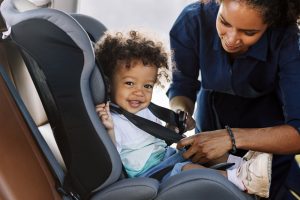Fortunately, the days where seatbelts were optional are over. However, just because it’s illegal to not wear a seatbelt, doesn’t mean everyone wears a seat belt while in the car. Data from the National Highway Traffic Safety Administration found that of the 37,133 people that were killed in motor vehicle crashes in 2017, 47% were not wearing seat belts. Tragically, that percentage is even higher for teenagers ages 13 to 15 (54%).
While we preach the importance of wearing a seat belt anytime we are inside a moving motor vehicle, many people continue to forgo these life-saving devices. Read on to learn more about the importance of seat belts as well as existing seat belt laws in DC, Virginia, and Maryland.
The most important reason to always wear a seat belt is because seat belts save lives. The NHTSA reports that between 1960 and 2012, seat belts saved 329,715 more lives than all other vehicle technologies combined. In 2017 alone, it is estimated that seat belts saved nearly 15,000 lives.
DMV Laws
There are two types of enforcement in seat belt law: primary enforcement and secondary enforcement. Primary enforcement means that the police can pull you over simply for not wearing a seat belt. Secondary enforcement means that the police can stop or cite a driver for a seat belt violation only if the driver committed another primary violation (like speeding or running a stop sign) at the same time.
While each state varies on the type of enforcement used in their seat belt laws, here is a breakdown of the seat belt laws in the DMV:
Understanding how seatbelt laws are enforced is important for your rights as a driver in DC, Virginia, and Maryland. However, it is also important to know the specifics of each state’s laws regarding seat belt wearing.
Given the increase in heavy traffic in the DC metropolitan area, there are very specific rules drivers must follow regarding seat belt wearing–specifically for children.
Below is an overview of DC seat belt laws.

Failure to comply with the law regarding child restraints can result in a fine of at least $75 and two points on the driver’s license. Further, the driver will have to attend a child restraint safety class. In Washington, DC, the police can stop a driver for not having a child properly restrained, even if they have been driving properly otherwise.
The more times a driver violates these laws, the higher the fine is.
Under DC law, the driver of a motor vehicle and all passengers must wear a seatbelt at all times, in the front and back seats. This requirement applies to all vehicles including rideshare and taxicab services.
Failure to comply with Washington, DC seatbelt laws can result in a $50 fine and two points on the driver’s license.
As defined by the Virginia Department of Motor Vehicles, “Virginia law requires everyone under age 18 to be properly secured in a safety belt or child safety seat no matter where they are sitting in the vehicle…In addition, Virginia law requires everyone in the front seat of vehicles to be properly restrained, regardless of age, and those 18 and older can be ticketed.”
Under Virginia’s Child Safety Seat Law, the following safety measures are required of child passengers:
If a driver is found guilty of violating any Virginia Child Safety Seat laws, they may face a $50 civil penalty fine for the first offense. For a second or subsequent time, the driver can be fined up to $500. An additional $20 civil penalty fine is possible if the driver of a child who is exempted from this law due to medical reasons does not carry a written statement of the exemption.
According to the Maryland Department Of Transportation, Motor Vehicle Administration, all drivers, and passengers must wear a seat belt. For children under eight years old, the child must be in a booster or child safety seat, until they reach a height of 4 feet, 9 inches, or taller. Children under the age of 13 are recommended to sit in the backseat of a vehicle.
Drivers with passengers older than 16 years old, who are not wearing a seatbelt, can receive an $83 ticket for each offense.
The NHTSA estimates that in 2020, more than half of passenger vehicle occupants who died in car accidents were unrestrained.
In addition, when reviewing seat belt use of teen drivers, roughly 43% of teen drivers do not always use a seatbelt. In 2019 alone, roughly 2,400 teens in the United States aged 13–19 were killed in car accidents, and about 258,000 were treated in emergency departments for injuries.
In addition, the Centers for Disease Control and Prevention found that of those fatalities, half of those ages 16–19 years old were not wearing seatbelts at the time of the collision.
By wearing a seat belt, thousands of lives could be saved each year.
Seat belts save lives, but unfortunately, when car accidents occur, they can result in fatality if a driver or passenger isn’t wearing one. If you or a loved one were involved in a car accident in DC, Virginia, or Maryland, the car accident attorneys of Regan Zambri Long can help you.
Our DC, VA, and MD car accident lawyers will review the facts of your case, determine negligence, calculate your total losses, and help you seek the compensation you deserve via negotiations with the insurance companies, or by representing you in court.
Our car accident lawyers have secured millions of dollars in settlements and verdicts for car accident victims, and we can do the same for you.
For a no-obligation, free consultation, call the DC, VA, and MD car accident lawyers of Regan Zambri Long at 202-960-4596 or by contacting us online.